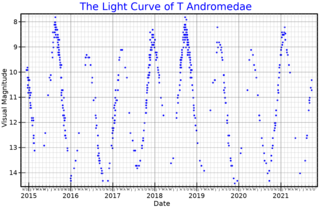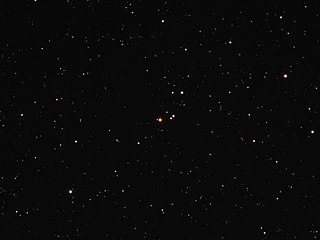
Chi Cygni is a Mira variable star in the constellation Cygnus, and also an S-type star. It is around 500 light years away.

Lambda Andromedae, Latinized from λ Andromedae, is the Bayer designation for a binary star system in the northern constellation of Andromeda. At an estimated distance of approximately 84.6 light-years from Earth, it has an apparent visual magnitude of +3.8. This is bright enough to be seen with the naked eye. The system is drifting further away from the Sun with a radial velocity of +6.8 km/s.

8 Andromedae, abbreviated 8 And, is a probable triple star system in the northern constellation of Andromeda. 8 Andromedae is the Flamsteed designation. It is visible to the naked eye with an apparent visual magnitude of 4.82. Based upon an annual parallax shift of 5.7 mas, it is located about 570 light years from the Earth. It is moving closer with a heliocentric radial velocity of −8 km/s.

28 Andromedae is a Delta Scuti variable star in the constellation Andromeda. 28 Andromedae is the Flamsteed designation. It also bears the variable star name GN Andromedae. Its apparent magnitude is 5.214, varying by less than 0.1 magnitudes.

63 Andromedae is an Alpha2 Canum Venaticorum variable star in the constellation Andromeda. Its variable star designation is PZ Andromedae. With an apparent magnitude of about 5.6, it is bright enough to be seen by naked eye. Based upon an annual parallax shift of 8.53 mas, it is located 382 light years away.

R Centauri is a Mira variable star in the constellation Centaurus. When it is near its maximum brightness, it is faintly visible to the naked eye under very good observing conditions.
Z Andromedae is a binary star system consisting of a red giant and a white dwarf. It is the prototype of a type of cataclysmic variable star known as symbiotic variable stars or simply Z Andromedae variables. The brightness of those stars vary over time, showing a quiescent, more stable phase and then an active one with a more pronounced variability and stronger brightening and/or dimming.

T Cephei is a Mira variable star in the constellation Cepheus. Located approximately 600 light-years distant, it varies between magnitudes 5.2 and 11.3 over a period of around 388 days. When it is near its maximum brightness, it is faintly visible to the naked eye under good observing conditions.

T Andromedae is a variable star of the Mira type in the constellation Andromeda. Like all the stars of this kind, T And is a cool asymptotic giant branch star of spectral type M4e-M7.5e. Its brightness varies periodically, completing a cycle in 281 days. The peak luminosity, however, is different every variability cycle, but can reach a peak magnitude mv=7.70.

OU Andromedae is a rotationally variable star in the constellation Andromeda. Varying between magnitudes 5.87 and 5.94, it has been classified as an FK Comae Berenices variable, but the classification is still uncertain. It has a spectral classification of G1IIIe, meaning that it is a giant star that shows emission lines in its spectrum. It is also likely in its horizontal branch phase of evolution.

LN Andromedae, also known as HD 217811, HR 8768, is a formerly suspected variable star in the constellation Andromeda. Located approximately 458 parsecs (1,490 ly) away from Earth, it shines with an apparent visual magnitude 6.41, thus it can be seen by the naked eye under very favourable conditions. Its spectral classification is B2V, meaning that it is a hot main sequence star, emitting light approximately with a blackbody spectrum at an effective temperature of 18,090 K.

An S-type star is a cool giant with approximately equal quantities of carbon and oxygen in its atmosphere. The class was originally defined in 1922 by Paul Merrill for stars with unusual absorption lines and molecular bands now known to be due to s-process elements. The bands of zirconium monoxide (ZrO) are a defining feature of the S stars.

W Andromedae is a variable star in the constellation of Andromeda. It is classified as a Mira variable and S-type star, and varies from an apparent visual magnitude of 14.6 at minimum brightness to a magnitude of 6.7 at maximum brightness, with a period of approximately 397.3 days.

RX Andromedae is a variable star in the constellation of Andromeda. Although it is classified as a dwarf nova of the Z Camelopardalis (UGZ) type, it has shown low-luminosity periods typical of VY Sculptoris stars. However, for most of the time it varies from an apparent visual magnitude of 15.1 at minimum brightness to a magnitude of 10.2 at maximum brightness, with a period of approximately 13 days.

SU Andromedae is a carbon star in the constellation of Andromeda. It is a variable star classified as a slow irregular pulsating supergiant, and varies from an apparent visual magnitude of 8.5 at minimum brightness to a magnitude of 8.0 at maximum brightness with no clear period.

DD Microscopii, also known as CD−43°14304, is a binary star system in the constellation Microscopium. The system has a combined average apparent magnitude around 11, making it readily visible in telescopes but not to the naked eye. It is thought to be at a distance of one or two thousand parsecs, although parallax measurements place the system at a distance of around 30,000 light years.

TV Geminorum is a variable red supergiant in the constellation Gemini. Its visual magnitude varies from 6.3 to 7.5, making it very faintly visible to the naked eye of an observer with excellent observing conditions, when the star is near its peak brightness.

S Cassiopeiae is a Mira variable and S-type star in the constellation Cassiopeia. It is an unusually cool star, rapidly losing mass and surrounded by dense gas and dust producing masers.

TU Andromedae is a variable star of the Mira type in the constellation Andromeda. It has a spectral type of M5e and a visual magnitude which varies between extremes of 7.6 and 13.5.

EG Andromedae is a symbiotic binary in the constellation Andromeda. Its apparent visual magnitude varies between 6.97 and 7.80.




















